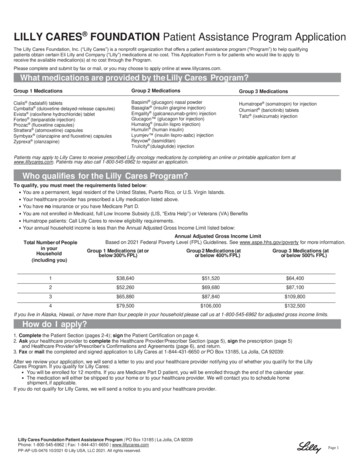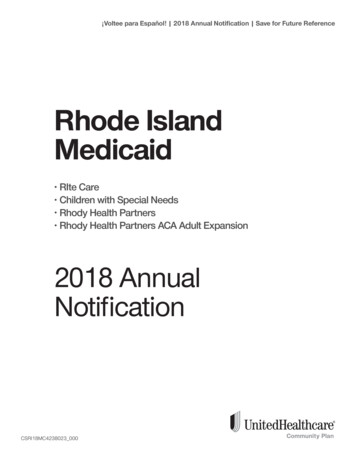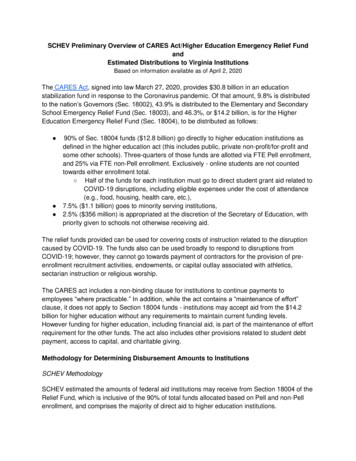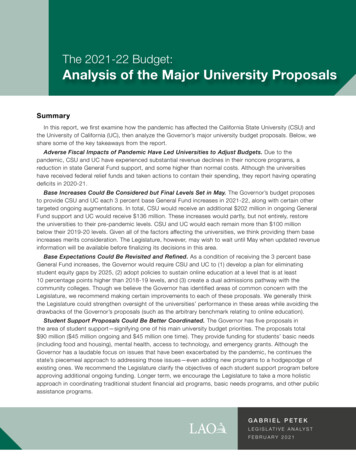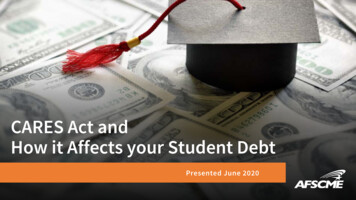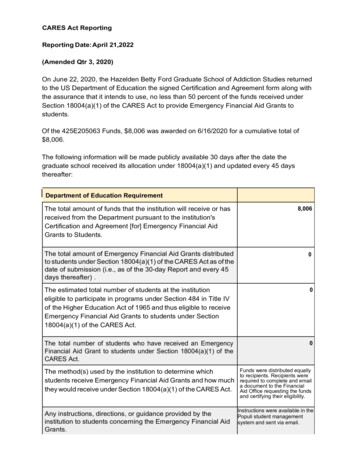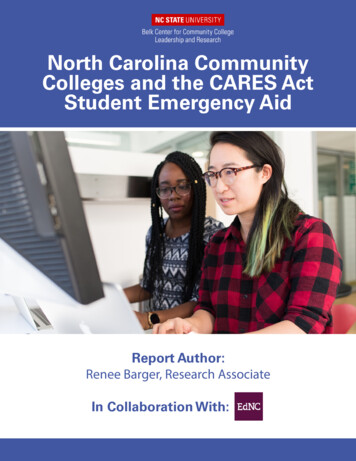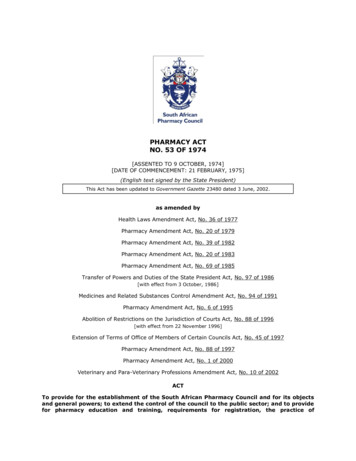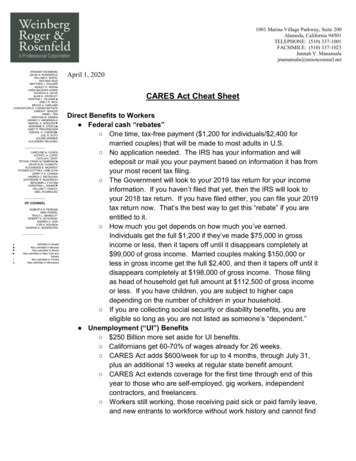
Transcription
1001 Marina Village Parkway, Suite 200Alameda, California 94501TELEPHONE: (510) 337-1001FACSIMILE: (510) 337-1023Jannah V. Manansalajmanansala@unioncounsel.netSTEWART WEINBERGDAVID A. ROSENFELDWILLIAM A. SOKOLANTONIO RUIZMATTHEW J. GAUGERASHLEY K. IKEDA LINDA BALDWIN JONESPATRICIA A. DAVISALAN G. CROWLEYKRISTINA L. HILLMAN EMILY P. RICHBRUCE A. HARLANDCONCEPCIÓN E. LOZANO-BATISTACAREN P. SENCERANNE I. YENKRISTINA M. ZINNENJANNAH V. MANANSALAMANUEL A. BOÍGUES KERIANNE R. STEELE GARY P. PROVENCHEREZEKIEL D. CARDER LISL R. SOTOJOLENE KRAMERALEJANDRO DELGADOCAROLINE N. COHENXOCHITL A. LOPEZCAITLIN E. GRAYTIFFANY CRAIN ALTAMIRANO DAVID W.M. FUJIMOTOALEXANDER S. NAZAROVTHOMAS GOTTHEIL (1986-2019)JERRY P.S. CHANG ANDREA C. MATSUOKAKATHARINE R. McDONAGHBENJAMIN J. FUCHS CHRISTINA L. ADAMS WILLIAM T. HANLEYABEL RODRIGUEZOF COUNSELROBERTA D. PERKINSNINA FENDELTRACY L. MAINGUY*ROBERT E. SZYKOWNYANDREA K. DONLORI K. AQUINO SHARON A. SEIDENSTEN * Admitted in HawaiiAlso admitted in NevadaAlso admitted in IllinoisAlso admitted in New York andAlaskaAlso admitted in FloridaAlso admitted in MinnesotaApril 1, 2020CARES Act Cheat SheetDirect Benefits to Workers Federal cash “rebates” One time, tax-free payment ( 1,200 for individuals/ 2,400 formarried couples) that will be made to most adults in U.S. No application needed. The IRS has your information and willedeposit or mail you your payment based on information it has fromyour most recent tax filing. The Government will look to your 2019 tax return for your incomeinformation. If you haven’t filed that yet, then the IRS will look toyour 2018 tax return. If you have filed either, you can file your 2019tax return now. That’s the best way to get this “rebate” if you areentitled to it. How much you get depends on how much you’ve earned.Individuals get the full 1,200 if they’ve made 75,000 in grossincome or less, then it tapers off until it disappears completely at 99,000 of gross income. Married couples making 150,000 orless in gross income get the full 2,400, and then it tapers off until itdisappears completely at 198,000 of gross income. Those filingas head of household get full amount at 112,500 of gross incomeor less. If you have children, you are subject to higher capsdepending on the number of children in your household. If you are collecting social security or disability benefits, you areeligible so long as you are not listed as someone’s “dependent.” Unemployment (“UI”) Benefits 250 Billion more set aside for UI benefits. Californians get 60-70% of wages already for 26 weeks. CARES Act adds 600/week for up to 4 months, through July 31,plus an additional 13 weeks at regular state benefit amount. CARES Act extends coverage for the first time through end of thisyear to those who are self-employed, gig workers, independentcontractors, and freelancers. Workers still working, those receiving paid sick or paid family leave,and new entrants to workforce without work history and cannot find
Page 2work. Note: Students who did work study at colleges and universities thathave now closed can under the CARES Act still collect pay for work studyhours scheduled. Retirement Benefits Employers may allow employees to “self-attest” to financial crisis. Employee may withdraw up to 100,000 due to COVID 19 related financialhardship. No 10% penalty if under 59.5 years. If deducting from something that is not a Roth IRA (like a 401k), you have 3years to pay taxes on the withdrawn amount or put it back into the accountwithout taxes. Alternatively, you can now take a loan out of your defined contribution plan foran amount up to 100,000 so long as you repay it within 5 years at a ratethat’s currently 4.5%. If you have an existing loan due by the end of this year, you get a one-yearextension. There are no Required Minimum Distributions in 2020 for those over 70.5 or72 years.Indirect Benefits for Workers Paycheck Protection Program (PPP) For Small Businesses, businesses with 500 or fewer employees, certainnonprofits (501(c)(3) and 501(c)(19), and independent contractors. Up to 10 million in loans. Loan amounts used to pay salaries, wages, benefits, rent, and utilities areforgiven. Loan forgiveness decreases if the employer lays off workers or reducespay/benefits within 8 weeks of the date of the origination of the loan, unlessthe employer rehires those employees or restores pay/benefits. Available through June 30, 2020. Emergency Injury Disaster Loans For small businesses, private nonprofits (possibly unions), sole proprietors,and independent contractors. Up to 2 million in disaster loans. Includes 10,000 advance to be paid 3 days after applying and does not needto be repaid. Employment Tax Credits for Businesses that do Not Participate in the PPP For businesses (small or large) that suffered substantial loss of profit or partialor complete closures in any particular quarter. Tax credit equal to half of each employee’s wages during any such quarter.
Page 3 Applies to up to 10,000 in employment tax credits per employee for wagespaid during any of those quarters from March 12, 2020 through December 31,2020.Loans for Medium-Sized Businesses (501 to 10,000 employees) Loans available for up to 5 years and are listed publicly. Must agree to remain neutral in any union organizing effort during the term ofthe loan. Must agree to abide by Collective Bargaining Agreement if they have one untiltwo years after repaying loan. At least 90% of loan must be used to retain 90% of workforce at fullcompensation until September 30, 2020. Banned from offshoring any jobs for at least 2 years after loan repaid.Loans for Public Entities The Federal Reserve will develop a program to facilitate lending to states andmunicipalities.Public Entities, Including Transit Agencies and Education 150 Billion to Local Governments to reimburse for unexpected Covid-19expenses to the end of the year. 45 Billion to State/Local Governments for disaster relief. 25 Billion to Transit Agencies for operating expenses, lost revenue, PPE, andpaying for leave during service reductions. 13.5 Billion to K-12 schools for Covid-10 expenses and keeping teachinggoing. 14.25 Billion for Higher Education for student aid, responding to Covid-19,backfilling lost revenue, etc. 38 Billion to States to help schools and colleges keep operating. 5 Billion to Community Development Fund.Airline Industry 31 Billion for airline industry workers, through September 30. 25 Billion for 750,000 airline industry workers (e.g., atAmerican/United/SWA, 80-85% workforce unionized). 4 Billion for cargo airline workers. 3 Billion for contractors: 22,000 food service workers, janitors,cleaners, security workers, and wheelchair operators. Money will go to airlines and contractors, but unions can bargain withemployers on how the money will be distributed to workers.Healthcare Industry 100 Billion to health care providers for expenses/lost revenues. 27 Billion (through 2024) for vaccines; to fund workforce modernization, andtelehealth expansion.
Page 4 16 Billion for the Strategic National Stockpile (PPE, drugs, drugadministration equipment, vaccines, and medical devices). 180 Million for rural telehealth and activities. 1.32 Billion more for Community Health Centers. Additional funds for Medicare improvements - Certain services paid at 100%instead of 70%. Increased funding to States for Medicaid. Non-expansion States can use it for uninsured adults for COVID-19services. 79.5 Million per year to improve health care delivery to rural underservedpopulations. Health Plan Requirements Health plans must fully cover COVID-19 testing. Health plans must provide COVID-19 “preventive services” such as servicesrecommended by the United States Preventive Services Task Force andvaccines and immunizations recommended by the CDC. High Deductible Health Plans with Health Savings Accounts can covertelehealth services before patient reaches deductible limits. Other Industries 1 Billion to Defense Department to increase manufacture of PPE and medicalequipment for healthcare workers. 1.5 Billion to triple 4,300 beds in military facilities. 1 Billion for tribal health systems. 4.3 Billion to CDC to combat and contain virus. 9.5 Billion for Agricultural Producers.Other Benefits for Workers Food Assistance 15.5 Billion set aside for Supplemental Nutrition Assistance Program(“SNAP”) (Food Stamps). 8.8 Billion for Child Nutrition Program. 450 Million for food banks and other community food distribution centers. Student Loans Relief for those with federal DIRECT loans: All payments suspended through September 30, 2020. No interest for suspension period. Watch loan notices closely; don’t rely on loan processors to handle thiscorrectly. Employers can offer up to 5,250 to help workers repay loans/covertuition expenses, and that amount won’t be taxed as income. Doesn’t apply to Perkins loans, Discover loans, and Sallie Mae.
Page 5 Renter Relief Federal Relief: Applies to renters whose landlords have mortgages backed by Fannie,Mae, Freddie Mac, and other federal entities. 4-month suspension on all evictions for failure to pay rent. Landlords can’t charge penalties or fees during this period. State Relief: 90-day grace period for mortgage payments. No foreclosures or evictions by lenders for at least 60 days. For at least 90 days, waiver of late fees. Child Care 3.5 Billion for child care programs to maintain critical operations. To ensure first responders, health care workers, sanitation workers, andothers deemed “essential workers” can access child care. For more information, look online for your state’s department or agency thatoversees Child Care Development Block Grant programs. Veterans 16 Billion to help cover treatment of veterans for coronavirus: For VA Hospitals, and Community Urgent Care Clinics and EmergencyRooms. For VA: to cover overtime for clinical staff; purchase of PPE, test kits,and equipment to treat vets for virus-related maladies. Charitable Contributions Up to 300 can be subtracted from the year’s gross income. Charitable Contributions to public charities are 100% deductible from adjustedgross income for 2020 taxes. Assistance with Utilities 900 Million for the Low Income Home Energy Assistance Program. To help low income households with heating, lighting, energy-relatedhome repair and maintenance.o 600 Million in Community Services Block Grants to States, which can beused to cover utility costs.JVM:mdaopeiu 29 afl-cio(1)149268\1077071
CARES Act Cheat Sheet Direct Benefits to Workers Federal cash "rebates" One time, tax-free payment ( 1,200 for individuals/ 2,400 for married couples) that will be made to most adults in U.S. No application needed. The IRS has your information and will edeposit or mail you your payment based on information it has from
